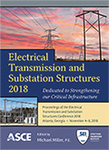Electrical Transmission and Substation Structures 2018
Embrittlement in T.L. Lattice Steel Structures Specifying Energy Absorption Criteria
Publication: Electrical Transmission and Substation Structures 2018: Dedicated to Strengthening our Critical Infrastructure
ABSTRACT
The transmission industry is increasingly specifying what is sometimes referred to as “notch tough” steel for lattice transmission towers. Notch-tough is a type of steel, which meets certain specified strength requirements as well as a specified impact property (Charpy V-Notch) requirement. Historically, lattice towers have performed well, even in extreme cold, without notch-tough steel being specified. Proponents of notch-tough steel for transmission towers offer that such a specification provides dynamic resistance to impact loading and provides better low temperature performance. While this cannot be disputed, one must consider the historical performance of their structures, the expected loading on their lines, and the cost of introducing notch-tough steel. As notch-tough steel is not widely used in the steel industry for general steel construction, it is worth considering why it is increasingly being specified for transmission structures. As notch toughness provides material the ability the absorb energy in the presence of a defect, it may not provide the cold temperature impact strength desired when specified. Understanding what notch toughness can provide and what it cannot is the responsibility of the transmission line engineer. While it may provide piece of mind, it should not be used to replace the design and detailing practices set forth in ASCE 10-15, rigorous quality control program, or experienced engineering judgment. This paper provides a set of recommendations to identify if the supplemental toughness requirement for steel is to be specified on lattice steel towers, based upon experience and knowledge from four different perspectives: the asset owner’s perspective, a metallurgical perspective, a manufacturing perspective, and an engineering perspective.
Get full access to this article
View all available purchase options and get full access to this chapter.
REFERENCES
American Welding Society. (2015, July 28). Structural Welding Code - Steel, 23rd Edition. AWS D1.1. USA: AWS.
Anderson, T. L. (2005). Fracture Mechanics: Fundamentals and Applications. CRC Press.
ASTM International. (2011). ASTM A709 / A709M - 17. Standard Specification for Structural Steel for Bridges. ASTM.
ASTM International. (2014). ASTM A143 / A143M - 07(2014). Standard Practice for Safeguarding Against Embrittlement of Hot-Dip Galvanized Structural Steel Products and Procedure for Detecting Embrittlement. ASTM.
Bernstein, I. M., & Thompson, A. W. (1976). Int. Metall Rev., Vol 21. 269-287.
Bhadeshia, H., & Honeycombe, R. (2017). Steels, Microstructure and Properties. In H. Bhadeshia, & R. Honeycombe, Steels, Microstructure and Properties (pp. 303-340). Cambridge: Butterworth-Heinemann (Elsevier).
Boyd, G. M. (1970). Fracture in Steel Structures. London: Butterworth & Co.
Cekov, Y. C. (2006, August). Tensile and Fatigue Behavior of Structural Steel Plates with Slotted Holes. Thesis. Austin, Texas, USA.
Collins, W., Sherman, R., Leon, R., & Connor, R. (2016). State-of-the-Art Characterization.II: Correlations between Charpy V-Notch and the Master Curve Reference Temperature. America Society of Civil Engineers.
Dieter, G. E. (1988). Mechanical Metalurgy. McGraw-Hill.
Gere, J. G. (2000). Mechanics of Materials. CL Engineering.
Holmes, J. D. (2015). Wind Loading of Structures. Boca Raton: CRC Press.
Johnson, W. H. (1875). On Some Remarkable changes produced in iron and steel by the action of hydrogen and acids. Proceedings of the Royal Society of London 1875 23 (pp. 168-179). London: Royal Society of London.
Kilinger, C., Mehdianpour, M., Klingbeil, D., Häcker, R., & Baer, W. (2011). Failure analysis on collapsed towers of overhead electrical lines in the region Münsterland (Germany) 2005. Elsevier, 1,3,5,7-9.
Lassila, D. H., & Birnbaum, H. K. (1987). Acta Metall., Vol 35. 1815-1822.
Robertson, I. M., & Birnbaum, H. K. (1986). Acta Metall., Vol 34. 353-366.
Rolfe, S. (1980). Fracture Fatigue Control in Steel Structures. Engineering Journal / American Institute of Steel Construction, 2, 7-14.
Structural Engineering Institute; American Society of Civil Engineers. (2010). Guidelines for Electrical Transmission Line Structural Loading. Reston: American Society of Civil Engineers.
Thompson, A. W. (1985). Material Science Technology, Vol I. 711-718.
Information & Authors
Information
Published In
Electrical Transmission and Substation Structures 2018: Dedicated to Strengthening our Critical Infrastructure
Pages: 312 - 324
Editor: Michael Miller, SAE Towers
ISBN (Online): 978-0-7844-8183-7
Copyright
© 2018 American Society of Civil Engineers.
History
Published online: Nov 1, 2018
Published in print: Nov 1, 2018
Authors
Metrics & Citations
Metrics
Citations
Download citation
If you have the appropriate software installed, you can download article citation data to the citation manager of your choice. Simply select your manager software from the list below and click Download.
